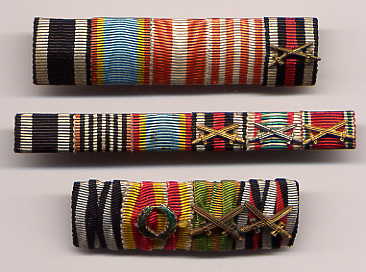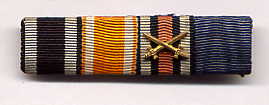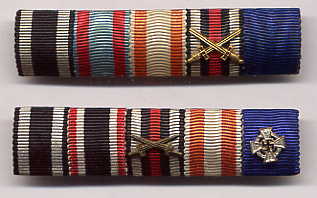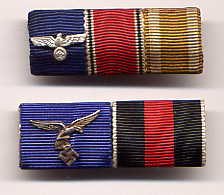
Content - Richard Lundström
Layout - Sebastian Bianchi
Third Reich-1930s
Out of the chaos and mess of the first German republic came the enforced regimentation of the Nazi "Thousand Year Reich." In March 1935, with reestablishment of the Wehrmacht, Hitler decreed that the 1914 Iron Cross-in reality Imperial Germany's common "Reichs" award-would henceforth assume pride of place on all medal and ribbon bars. It was the end of the semi-independent local states of the Imperial and Weimar periods. The explosion of awards created between 1934 and 1939 led to constant flux in regulations, ambiguity, confusion, and misinterpretation of regulations. "Everyone" was either back in uniform-or wanted to be.
This sadly worn and dingy bar, which appears to be on NSDAP uniform backing, manages to combine an eccentric post-1938 Anschluss precedence with individual whim-and yet can only date from the early months of 1934, before establishment of the Hindenburg Crosses.
|
|
| The awards are Iron Cross, Bavarian Military Merit Order, Württemberg Military Merit Order, Austro-Hungarian Military Merit Cross 3rd with War Decoration, Bremen Hanseatic Cross, Austro-Hungarian 1914 Red Cross Decoration, Austrian Republic WWI Commemorative Medal with Swords-dating this bar, Bavarian 1905/11 Army Jubilee Medal, Württemberg Long Service award, Turkish War Medal Star, Turkish Silver Liakat Medal with Sabers Bar, and Turkish Silver Imtiaz Medal with Sabers Bar. TP |
The combination suggests an officer from Field Artillery Regiment 49 who has chosen to wear his Bavarian awards ahead of his own states (!?!), jumbled Austria-Hungary's as "German," yet followed the "in order received" rather than "highest first" with his Ottoman awards.
|
|
| The second ribbon on the bottom bar is for Baden's Military Karl Friedrich Merit Order-288 awarded in WWI |
Less impressive-and also in compliance with period regulations (!) are these three ribbon bars, dating 1935-38. The top and bottom bars certainly belonged to ex- or recalled officers, and all indicate that the wearer was obviously wearing uniform of some kind.
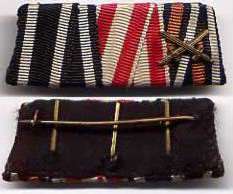
This unusual style ribbon bar was probably NOT worn in uniform, but rather on the lapel of a civilian jacket. It is not a naval trapezoid style, but rather a miniature of the old enlisted men's full size parade dress medal bar. Note the hooks on back for wearing miniature awards. There is no sin that miniatures were ever worn, and the swords device would not have been proper if the cross itself WAS worn. So this may have been worn as a ribbon bar after all.
Part of the confusion in precedence regulations was mixing the civil and military awards of all the former German states-and soon, Austria-into a coherent and rational system. Authoritarian as they were, the Nazis never actually succeeded in forcing recipients of decorations to bend to the new, arbitrary-and often stupid-rules. A prime example is the unfortunate fate of the prestigious Life Saving Medal under the Third Reich.
|
|
| The Prussian Life Saving Medal, which used the same ribbon from 1833 to present, is second on this bar. |
Almost every state in Imperial Germany had its own award for lifesaving at the risk of the rescuers own life. In Prussia, their medal was to be worn before all peacetime Orders, regardless of grade, and behind only war orders on the "Iron Cross" ribbon-recognizing the high esteem of civil valor. Nazi Germany inexplicably dumped the Lifesaving Medals of all states behind the Hindenburg Cross-and worse indignities would follow! There were constant protests at the insulting devaluation of Germany's highest awards for civilian valor-and many of the few recipients simply flouted idiotic rules and wore their medals as THEY valued them.
Peacetime Orders and medals also fell afoul of changing political winds. Although most pre-World War recipients of these decorations labored entire lives for their home state's basic rewards, many an aristocratic "lounge lizard" and court flunky was bedecked in glittering baubles for little more than showing up on parades or lighting some visiting potentate's cigarette. To "punish" such overly lavish displays of splendor, the Third Reich bumped peacetime decorations from before war medals and long service awards to after these. According to strict interpretation, such pre-WWI decorations came last after ALL other German awards. In reality, as was the case with Lifesaving Medals, recipients (well into middle age or approaching retirement) simply sprinkled peacetime Imperial awards where, again, they themselves valued them.
|
|
The upper bar shows a Prussian Red Eagle Order after WWI combat decorations and in front of the Hindenburg Cross, echoing what would have been Imperial practice, circa 1935. the lower bar, showing that the conflict of official regulations and personal opinion were still unresolved during the war, has a Red Eagle Order or Medal after the Hindenburg Cross, but ahead of a 25 Years Civil Service Cross. This was the most common "compromise" with precedence regulations.
|
|
| The awards are Iron Cross, Baden Order of the Zähringen Lion with Swords, Bavarian Military Merit Order 4th Class with Crown and Swords, Oldenburg Friedrich August Cross, Hindenburg Cross, China 1900-01 Medal, Luftwaffe 25, Luftwaffe 12, and Prussian Crown Order 4th Class. |
This bar, a sew-on variety (note the Luftwaffe backing), is in "perfect" compliance with regulations. It belonged to Thilo von Lattorff (1881-ca 1960), who was discharged from the Imperial navy as a gunnery Fregattenkapitän zur See and returned to Luftwaffe service as a flak Oberst (E). His former navy XXV Years Long Service Cross was replaced by the new double Luftwaffe awards in October 1936. The fact that any Order, regardless of why, how-or even if-earned, was placed after a long service medal is simply a statement of Nazi political and social contempt for the privileges and class structure of the former Imperial system.
|
|
| Note the unusual over large eagles peculiar to one as yet unidentified maker. |
But eccentricity, even in the reorganizing Wehrmacht, WAS tolerated, perhaps not even noticed in all the constantly changing reams of new rules. This naval administrative official, who was approaching 40 years of service, chose to insert not only his Red Eagle Order or Medal ahead of his Wehrmacht Long Service Awards, but also tucked in his lowly 1897 Centenary Medal there as well!
|
|
Such confusion did not affect the younger soldiers. Junior officers and NCOs with service only dating from the Weimar or early Third Reich years (these military long service awards were suspended in 1940 for the duration of the war) could scarcely hope for more than a 4 years service medal or one or two of the so-called "flower campaign" medals of 1938 and early 1939. Without Imperial service and awards, it is highly unusual to find ANY "all Third Reich" ribbon bar with more than 5 or 6 German awards, at most.
|
|
While military holders of old Imperial long service awards rolled them over into the new Wehrmacht ones, non-armed forces personnel were allowed to continue wearing them, "double dipping" with the array of new political and civil long service awards that also counted previous military service under the old Empire. This policeman correctly wore his former Prussian or Navy long service award in front of his new Police 25 Years Service Cross.
Even civil servants could now aspire to uniforms festooned with decorations. Most-Hollywood to the contrary!-were modest displays.
|
|
This one is typical of a "normal" ribbon bar for an average functionary during the Third Reich. He was a veteran of the First World War, but saw no combat, put in 25 thankless and under-appreciated (no more Imperial medals and Orders!) years of service, and received some recognition as one of the 54,915 people who received the 1936 Olympic Games merit medal for organizational and support work. He could have been a postman-or a Gestapo agent!
|
|
This impressive array to a former Bavarian officer shows the sort of display a former officer, just turning 60, could rack up-especially with a bit of "padding" at the end. His 5th ribbon is for the 1920s Crown Prince Rupprecht Medal, an unofficial but dynastic award (one of half a dozen bestowed by the Wittelsbachs into the early 1930s) the presence of which here proudly announces that THIS wearer held with "the old ways." Although he received no non-German WWI decorations, at the end we find the Austrian (1932/33), Hungarian (1928), and Bulgarian (for Germans, usually ca 1938) WWI Commemorative Medals, which were bestowed on German veterans simply upon application. Many former WWI veterans availed themselves of these free medals to bring back some of the "oomph" of the vanity/private association 19s-though these foreign awards WERE officially recognized.
Even Austria was no longer "foreign." Though the bar above shows a transitional phase, 1938 (from the 40 Years Loyal Service civil service cross), the Austrian WWI Commemorative medal above was still at the end, as a foreign award was supposed to be. With absorption of Austria into the Thousand Year Reich, its awards simply became that of all the other "German" states, and had to be fitted into common precedence.
|
|
| From the 1908 Military Jubilee Cross ribbon in next to last place, and absence of long service awards, this man was probably a wartime reserve NCO. |
This bar itself shows a transition phase from Austrian to German. The Habsburg 40 mm ribbons (see section on non-German and related ribbons after the main text) are gone, replaced by standard 15 mm size. The 1917 Karl Troop Cross in 3rd place, although only a campaign award for front service, was considered a "decoration" and as such preceded the German WWI Hindenburg Cross, which has pride of place over the Austrian and Tyrolean WWI Commemorative Medals. Most former Austro-Hungarian veterans who held their 1918 Wound Medals (4th ribbon shows one wound stripe) replaced them with the 1918 German version-this man has either not had time for his paperwork to go through, 1938/39, or liked his Austrian version better. Because of the myriad of Austro-Hungarian ribboned awards (ALL bravery awards-more than two dozen in all-used the same ribbons seen in first and second places here, in many cases utilizing miniatures of the specific awards to distinguish them), "huge" Third Reich bars are most often those of Austrian WWI veterans, usually of quite junior rank-it is a common beginning collector's error to equate length of a ribbon bar with importance of its wearer!
![]()
© Copyright Wehrmacht-Awards.com LLC |

